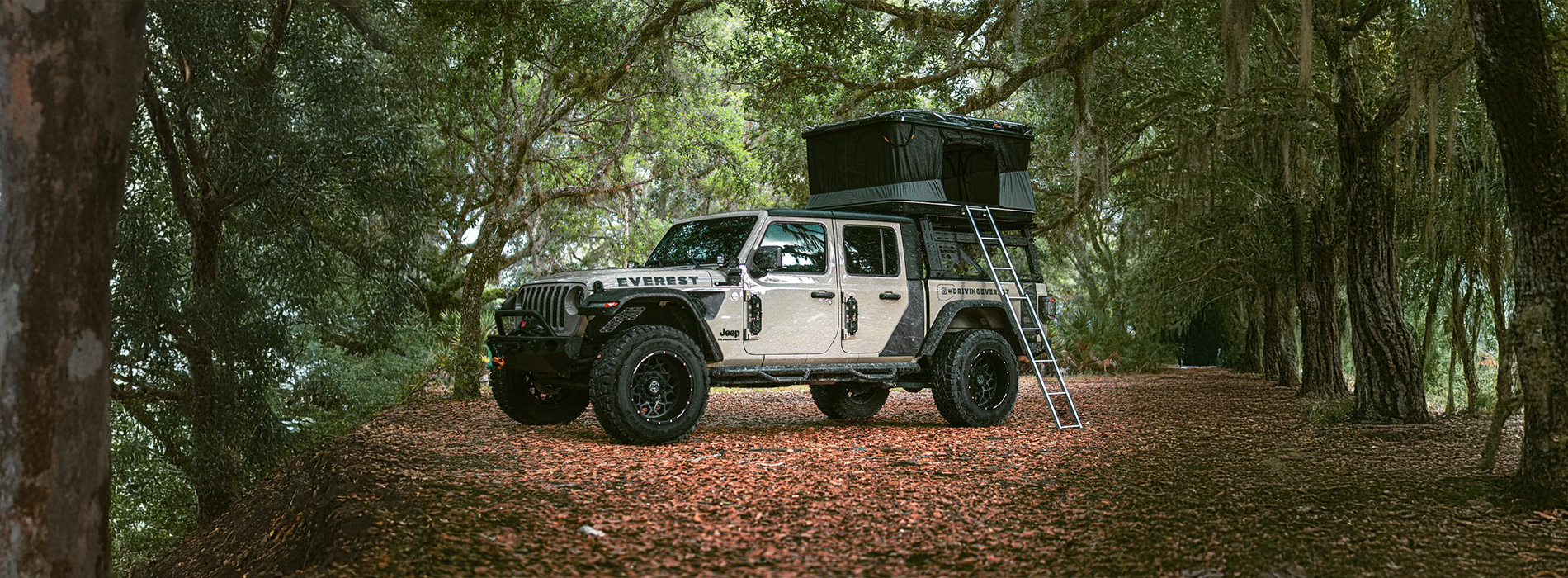
6 Jeep tent considerations for overlanding and camping
6 Nov, 2024
When it comes to overlanding, one of the most popular vehicle choices is the Jeep—renowned for its off-road capabilities and ruggedness. Whether you’re exploring mountain trails, desert dunes, or backcountry roads, a Jeep provides the freedom to reach remote, scenic locations. To maximize your Jeep’s potential, a rooftop tent is an excellent addition, allowing you to camp comfortably in the wild without the hassle of traditional ground tents. When planning your next adventure, keep key Jeep tent considerations in mind to ensure a comfortable, seamless overlanding experience in the wild.
Weight and compatibility with your Jeep
The weight of the tent and your vehicle’s roof load capacity are crucial considerations. Jeeps, like the Wrangler or Gladiator, come with specific load ratings that dictate how much weight the roof can support both when the vehicle is stationary (static load) and while driving (dynamic load). Overlooking these limits can lead to safety issues, affecting the stability of the vehicle, especially during off-road adventures.
Jeeps are famous for being convertible SUVs/pickups, with roofs that are easy to remove. They come with options of soft tops and hard tops. Inside the tops, there’s a frame called the roll bar, designed to protect passengers in case the vehicle “rolls” over. Therefore the weight capacity of the roof varies drastically whether the jeep has a soft top, a hard top or if the roof rack attaches to any part of the frame including the bumper or roll bar.
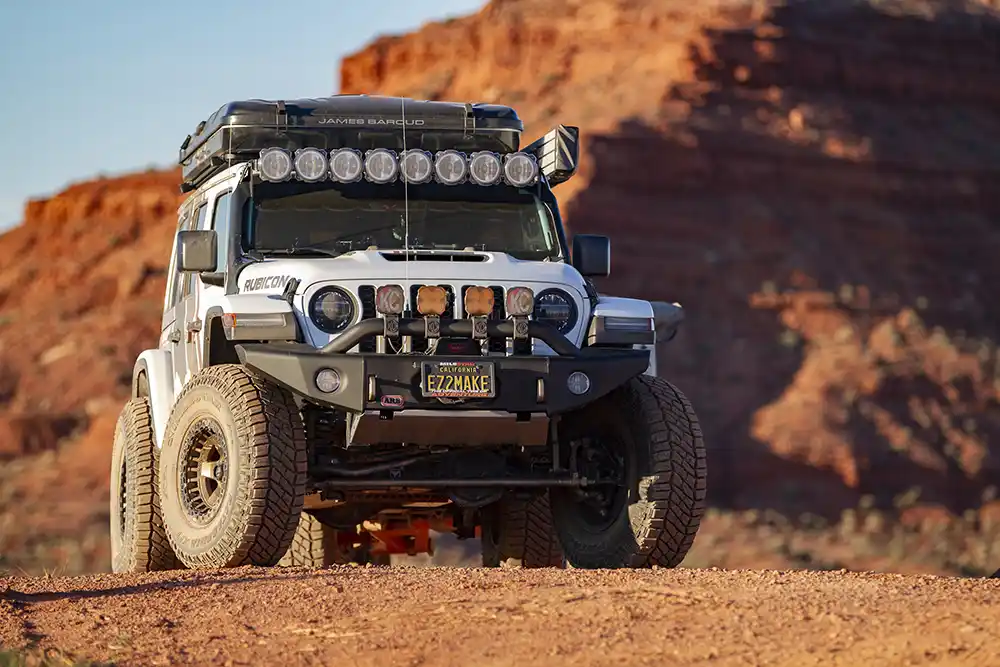
Jeep Wrangler Rubicon with an ARB Base Rack that is supported from the frame of the vehicle.
Properly balancing the tent’s weight with your Jeep’s capacity ensures a safer, smoother experience, both on the road and while camping. Always refer to your Jeep’s manual and consult with the tent manufacturer to ensure accessories are within the vehicle’s weight limit.
Hard-shell vs. soft-shell vs. hybrid rooftop tents
When it comes to rooftop tents, there are three main types to consider: hard shell, soft shell, and hybrids. This distinction is crucial, particularly for James Baroud, as many competitors in this price range market “hard shell” tents that are actually hybrids. The hard shell vs. soft shell classification differentiates tents based on their structure in the open position. For example, in a true hard-shell tent, if an object such as hail or debris falls vertically it will strike a solid surface like fiberglass, ABS, or aluminum, providing superior protection. In a soft-shell tent, the material is fabric, which, while durable, doesn’t offer the same level of impact resistance or sound insulation. Hybrids have a hard case that once opened a soft tent fold out. They combine both elements, with part of the tent roof being hard and part soft—useful to get the protection of a hard shell when closed not offering the full advantages of a true hard shell once it is opened.
Hard-shell tents are generally built from rugged materials like fiberglass or aluminum, delivering greater durability and resilience under harsh conditions such as wind, rain, snow, and UV rays. This solid construction provides excellent weatherproofing, keeping the interior dry and stable during storms and offering better insulation. Unlike soft-shell tents, the hard-shell design prevents flapping in the wind, ensuring comfort in all temperatures.
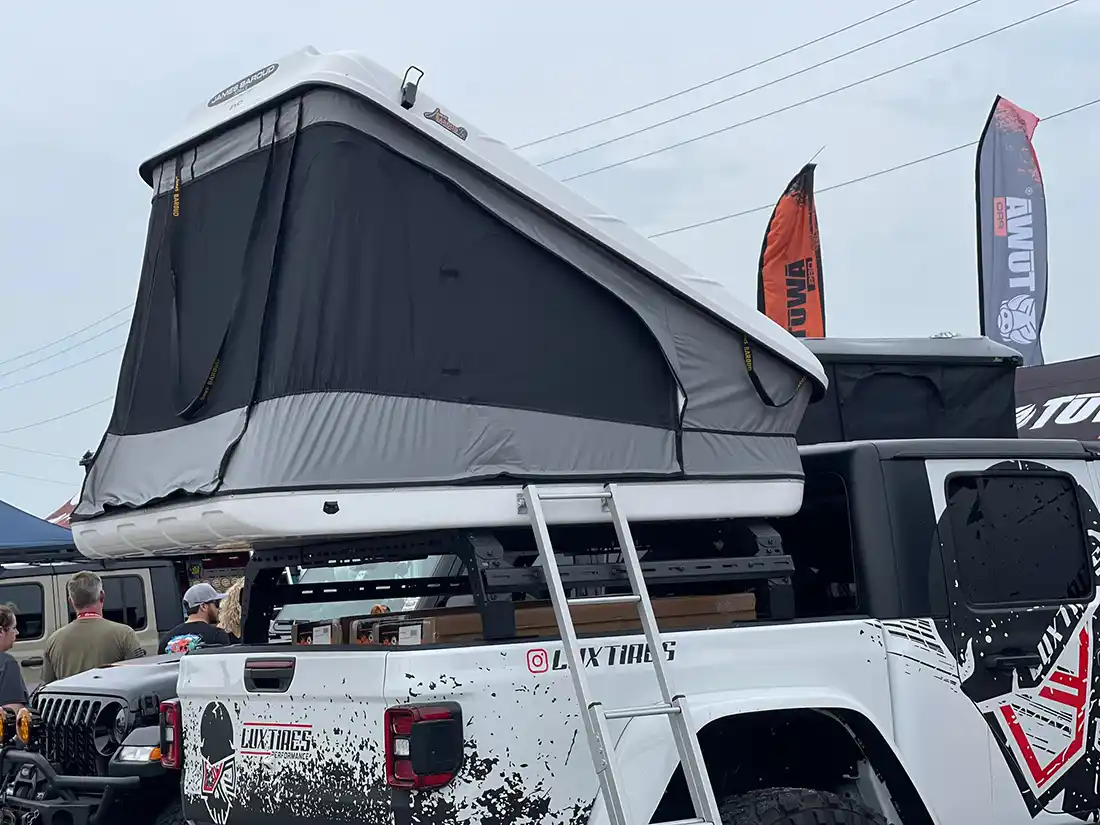
James Baroud Space roftop tent
Additionally, hard-shell tents are designed for quick setup, often featuring pop-up or gas strut mechanisms that open in seconds, making them perfect for overlanders who need a fast, hassle-free camping solution. Their streamlined, aerodynamic design minimizes wind resistance, improving fuel efficiency and adding stability on highways.
Thanks to their robust materials and weatherproof design, hard-shell tents have a longer lifespan than soft-shell models, making them a reliable investment for overlanders who face tough conditions on their adventures.
Size and interior space
When choosing a rooftop tent, size and interior space are key factors that directly affect your comfort and overall experience during an overlanding trip. First, consider the number of people who will be using the tent. If you’re traveling solo, a smaller, more compact tent might be enough, but if you’re overlanding with a partner or family, you’ll need a tent that offers ample sleeping capacity. Some tents are designed specifically for two to three people, while others can accommodate larger groups.
Beyond sleeping capacity, the interior layout plays a significant role in comfort. Look for features that enhance the sleeping environment, such as built-in foam mattresses that provide better support than thin sleeping pads. Adequate ventilation is also important, especially after a long day of off-roading. Tents with multiple windows, ventilation panels, or even built-in fans will help maintain airflow, preventing condensation buildup and ensuring a restful night’s sleep. Having enough room to store personal gear inside the tent is another consideration, particularly if weather conditions keep you indoors for extended periods. Choosing the right balance of space and comfort is essential for a successful overlanding trip.
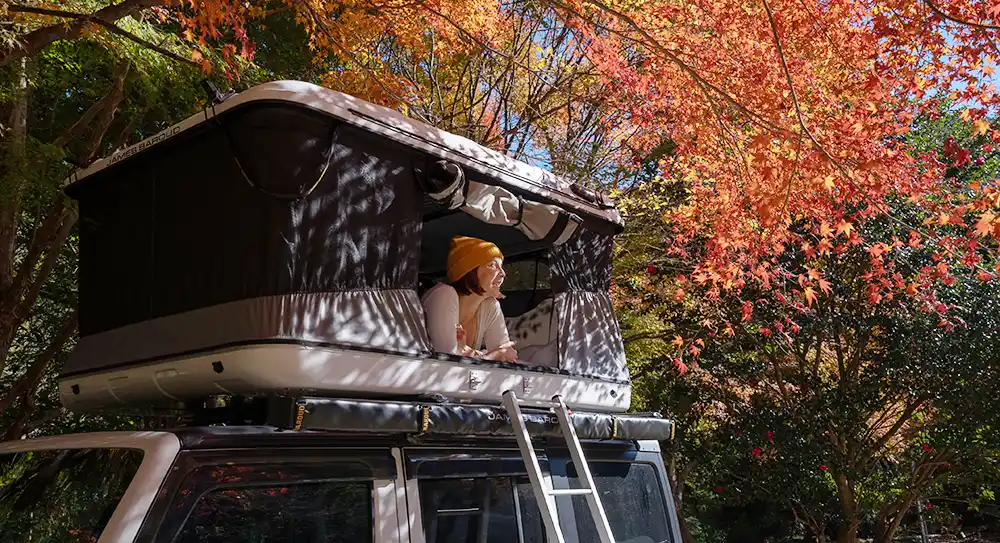
Hard shell rooftop tent spacious and comfortable for enjoying the views from within.
Specific models like the Grand Raid and Odyssey are very popular for Wrangler owners because they have dedicated storage locations above the tent allowing you additional storage room.
Jeep Wranglers are notorious for having very little interior storage room. Especially the 2 door version. For this particular model it is extremely important to have accessories that can be used for storage. James Baroud Evolution and Frontier series tents have room inside of the tents so you can store pillows, linens, sleeping bags, tables, chairs, skis and other items that do not fit inside of the wrangler. Specific models like the Grand Raid and Odyssey are very popular for Wrangler owners because they have dedicated storage locations above the tent allowing you additional storage room.
Our top choice for Jeep Wrangler and Gladiator with a full size rack is a medium Grand Raid. It is designed to take the beating of the trails, has additional storage on top of the tent, and the size fits perfectly with the roof. For the mid rack Gladiator the top choice is a Vision 150 Soft Shell tent. It would fit perfectly within the perimeter of the bed of the truck.
Weather resistance and durability
Weather resistance and durability are essential qualities in a rooftop tent, especially for overlanding, where you are exposed to a wide range of weather conditions. Whether it’s intense sun, sudden downpours, or strong winds, your tent must be equipped to handle it all. One of the first things to consider is the materials used in the tent’s construction. Opt for tents made from UV-resistant fabrics that won’t degrade under prolonged sun exposure, and ensure they are waterproof to prevent leaks during rainstorms. A tent with reinforced seams and a robust, weatherproof design will offer better protection in heavy rain, keeping the interior dry and comfortable.
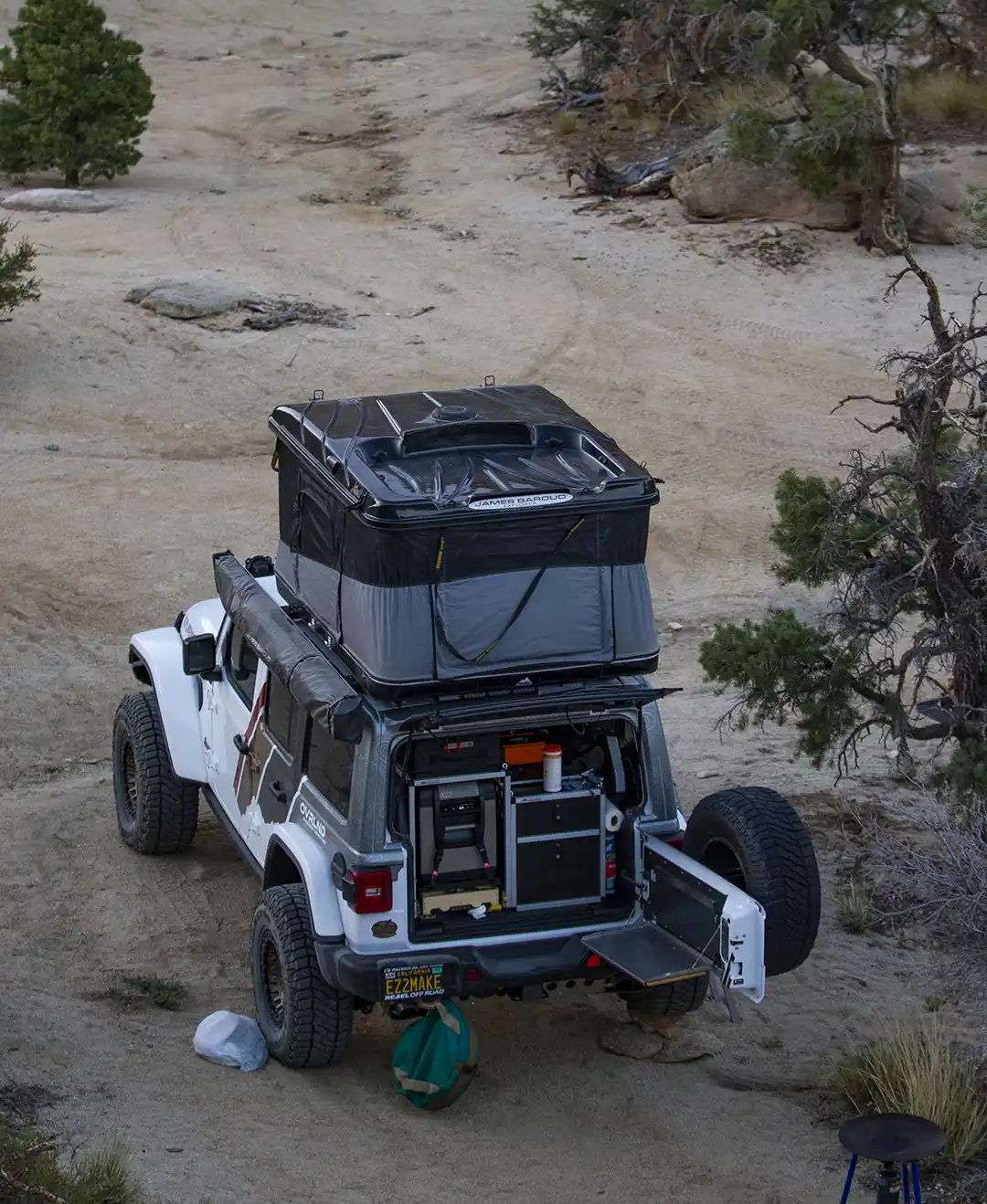
Jeep adventures with a James Baroud rooftop tent
Durability goes beyond just waterproofing; the tent should also be able to withstand strong winds, especially in remote, open environments where wind speeds can pick up quickly. A well-constructed rooftop tent will have a sturdy frame and reinforced stitching, allowing it to stay secure and intact even in adverse conditions. Durability also ensures that the tent can endure repeated setup and breakdown cycles without wear and tear, making it a long-lasting investment for frequent overlanders. Proper weather resistance and durability are key to ensuring comfort and safety during unpredictable outdoor adventures.
Ease of setup and breakdown
Ease of setup and breakdown is a crucial factor when overlanding, especially when camping in different spots, sometimes in challenging weather or low-light conditions. A tent that can be deployed and packed away quickly becomes a significant advantage, allowing you to spend more time enjoying your adventure rather than wrestling with your camping gear.
Tents with simple, efficient deployment mechanisms, like pop-up systems or gas struts, can typically be set up in under a minute. This eliminates the need for complicated poles or manual adjustments, making it much easier to set up camp after a long day of driving.
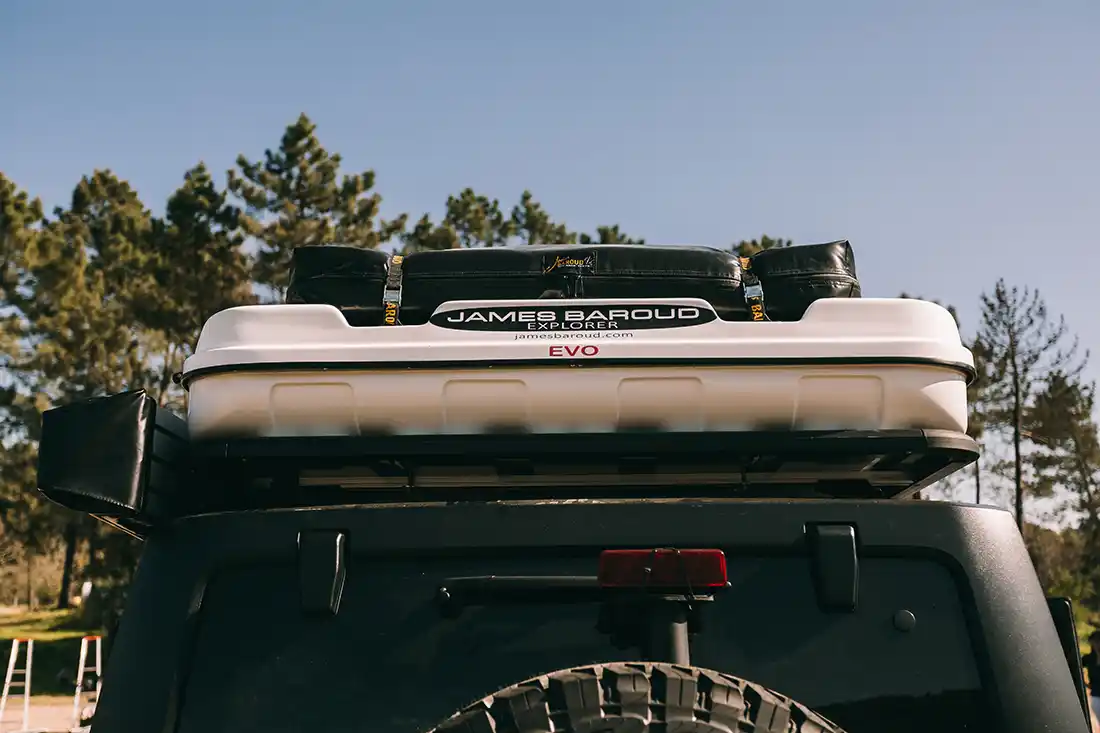
Quick set up and easy folding with James Baroud rooftop tents
Similarly, the breakdown process should be just as straightforward, allowing you to hit the road again without delay. Tents designed with easy-folding mechanisms, minimal latches, and compact storage options are ideal, reducing the hassle of packing up and ensuring that your tent remains in good condition through repeated use. The convenience of a quick setup and breakdown not only saves time but also contributes to a more relaxed and efficient overlanding experience.
Off-road Durability
Jeeps are often used for extreme offroad applications, and your rooftop tent should be able to handle the bumps and vibrations of off-road travel. Look for tents with robust construction and high-quality materials that can withstand challenging conditions.
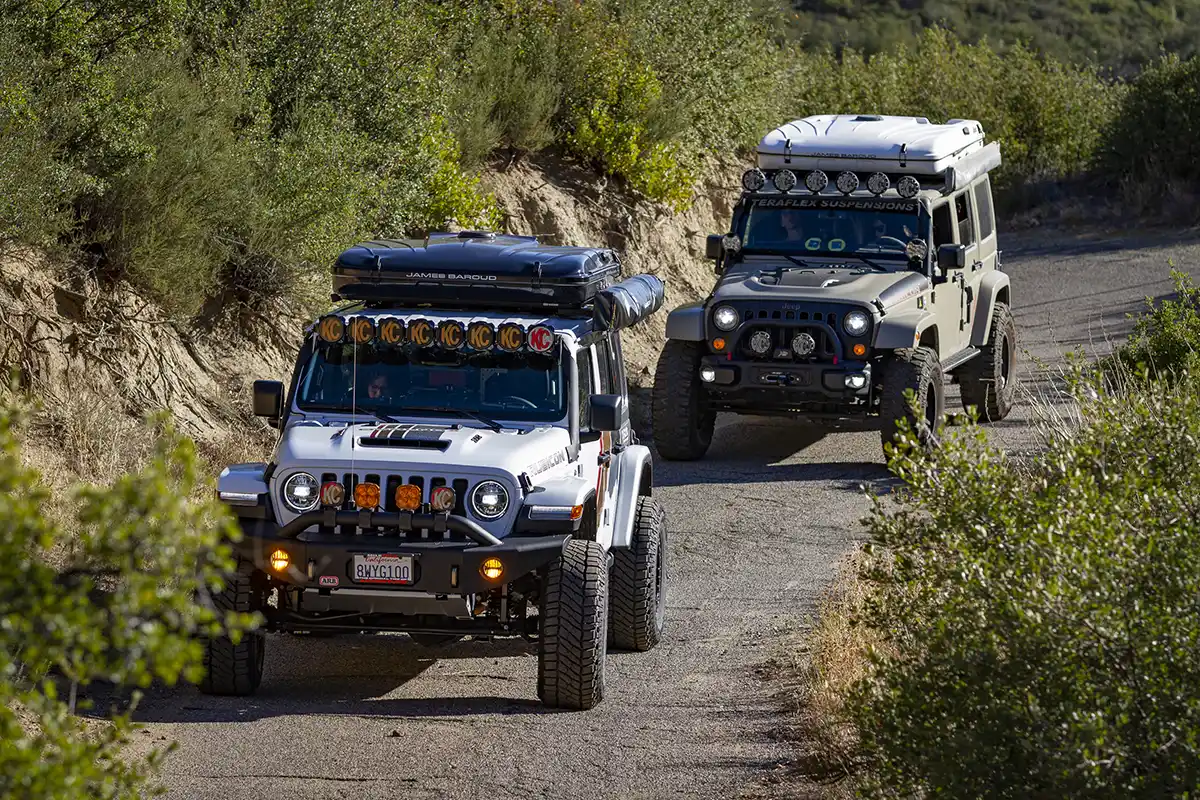
Overlanding Jeep adventures on all types of terrain
Fiberglass tents are reinforced in the lower shell to support extreme vibration and impact. The fabric should be tough and tear-resistant, ensuring it remains intact through dust storms, branches, or other potential hazards you may encounter off-road. Additionally, the mounting system that secures the tent to your Jeep must be reliable and stable, ensuring that the tent stays firmly in place during even the most intense off-road journeys. Investing in a tent with superior off-road durability means you can confidently explore remote and challenging locations without worrying about equipment failure.
When selecting a rooftop tent for your Jeep, durability is essential, especially for off-road adventures where rugged conditions are the norm. The materials used in your tent play a significant role in withstanding elements like dust, debris, and rough terrain. Not all materials are created equal, and choosing the wrong one can lead to faster wear and tear or even equipment failure during your journey. For a deeper look into what materials to avoid when selecting a rooftop tent, check out this article from James Baroud’s blog on 4 Materials to Avoid When Selecting a Rooftop Tent. Ensuring your tent is built from the right materials can make all the difference in handling the demands of off-road overlanding.
Gear Customization for your Jeeps in overlanding
Outfitting your Jeep for rooftop camping involves more than just installing a tent. It’s about creating a fully functional setup that enhances your overlanding experience. Here’s how to customize your Jeep for optimal comfort and functionality:
1. Roof racks and mounting systems: On Wranglers it is recommended to go with a rack system that attaches to the frame of the vehicle. Some like the Rhino Rack Pioneer system mount to the predrilled holes in the roll bars significantly increasing the weight capacity compared to a system that clamps to the rain gutters. The only trade off is the need to drill through the hard top of the wrangler and properly waterproofing the holes. If choosing a system that clamps to the rain gutter, look to increase the points of contact with the roof to spread the load.
For Gladiators, there are 3 typical mounting systems for the bed:
. Flush mount: Bars just above the tailgate as if the tent would be used as a tonneau cover.
Pro Tip: make sure the tent is wide enough to get the ladder angle. James Baroud M, X, XL tents fit this set up. For S tents you could off-center the tent or enter through the tailgate
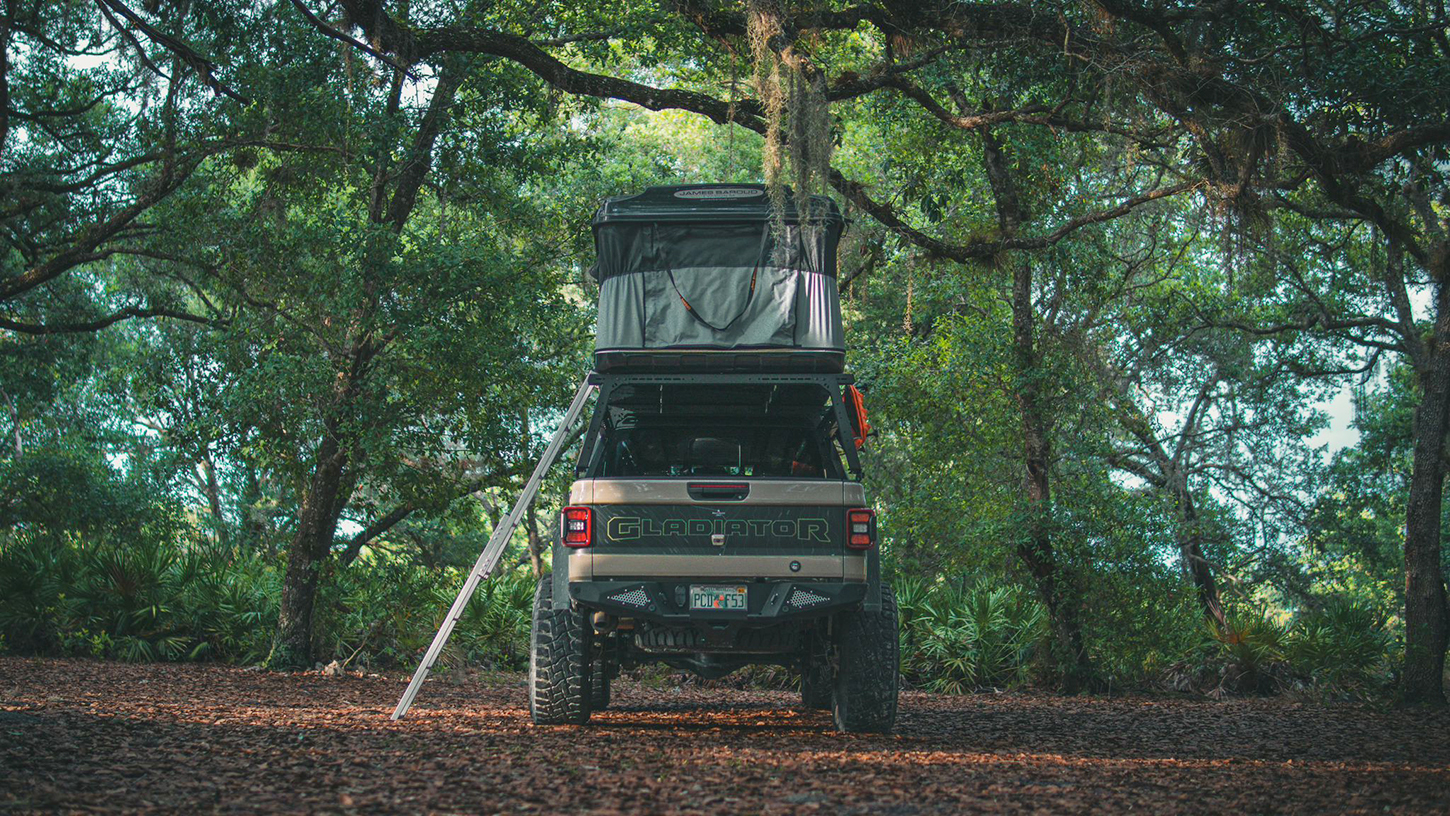
Overlanding in the wild with Gladiator Jeep and rooftop tent
. Mid height: These are between 9″-13″ high. The roof of the tent would be flush to the cab which is better for aerodynamics. Although if you are driving a Jeep, you are probably not too worried about aerodynamics. The height is usually very comfortable for opening and closing. The trade off is that it is difficult to install an awning since it would either be too low for comfort or it could interfere with the door.
Pro Tip 1: Hard shell tents will extend the back of the jeep which does not affect the performance of the vehicle or the tent but it is an aesthetics consideration.
Pro Tip 2: There might be some space required between the glass of the cab and the tent to allow the angles of opening and closing tents, hinges or clamps.
Pro Tip 3: Make sure the tent is wide enough for the ladder angle. James Baroud M, X , and XL tents fit this set up.
. Adjustable or full height: In this set up the rack is at the same height of the cab in a way that the front of the tent is over the cab. A popular variation of this style is “canopy enclosures. This setup allows you to use any size of tent, and move it forward or backwards for convenience. It is also easy to install awnings or other accessories. The trade off is that this raises the entire height of your vehicle which is something to consider depending the type of trails or if the vehicle is stored in a garage
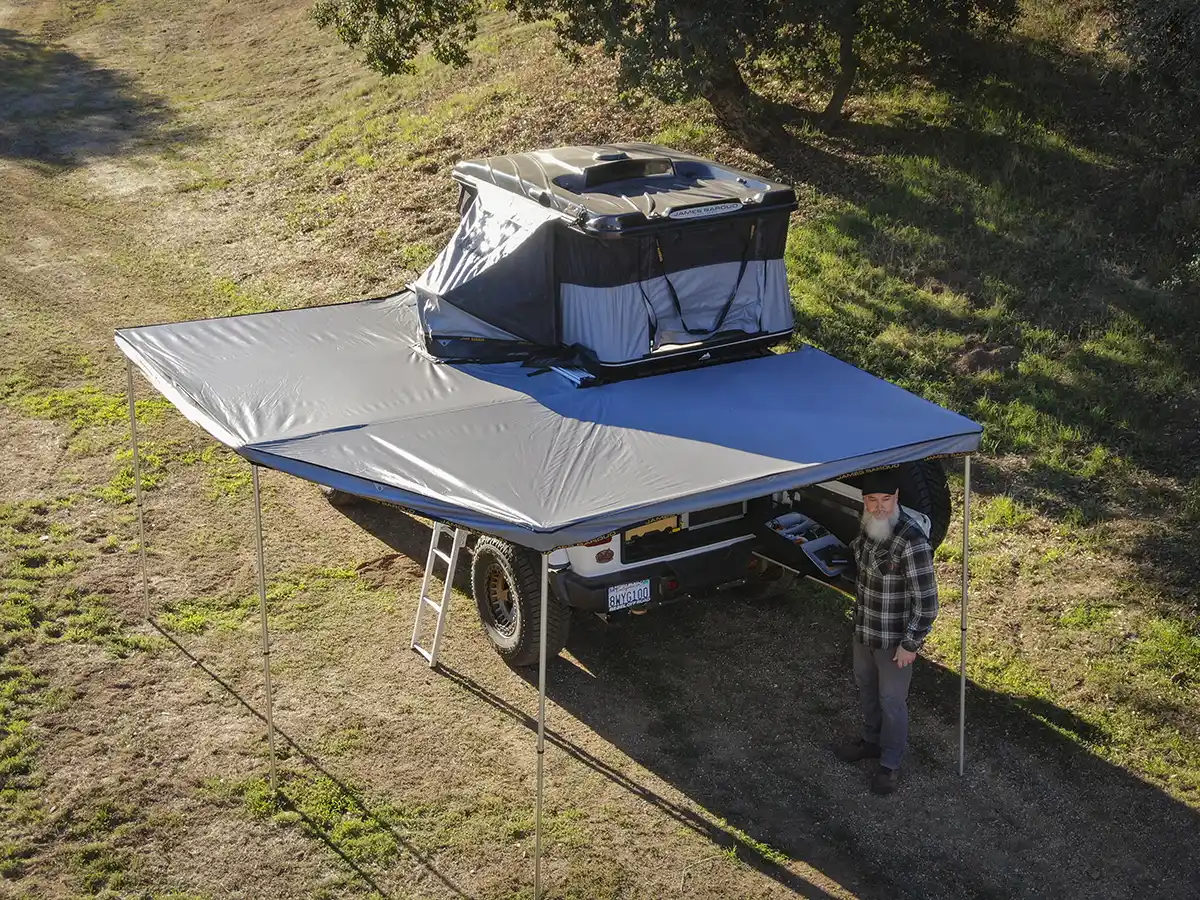
The 270º awning provides extensive coverage and protection creating a spacious shaded area around your vehicle.
2. Awnings and shade options: Adding an awning expands your campsite and provides protection from sun and rain, making your setup more versatile and comfortable.
3. Off-Road suspension and lift kts: Upgrading your suspension improves your Jeep’s ability to handle rough terrain, ensuring a smoother ride even with the added weight of a rooftop tent.
4. Auxiliary lighting for campsite visibility: LED lights or light bars can improve visibility around your campsite and make nighttime navigation safer.
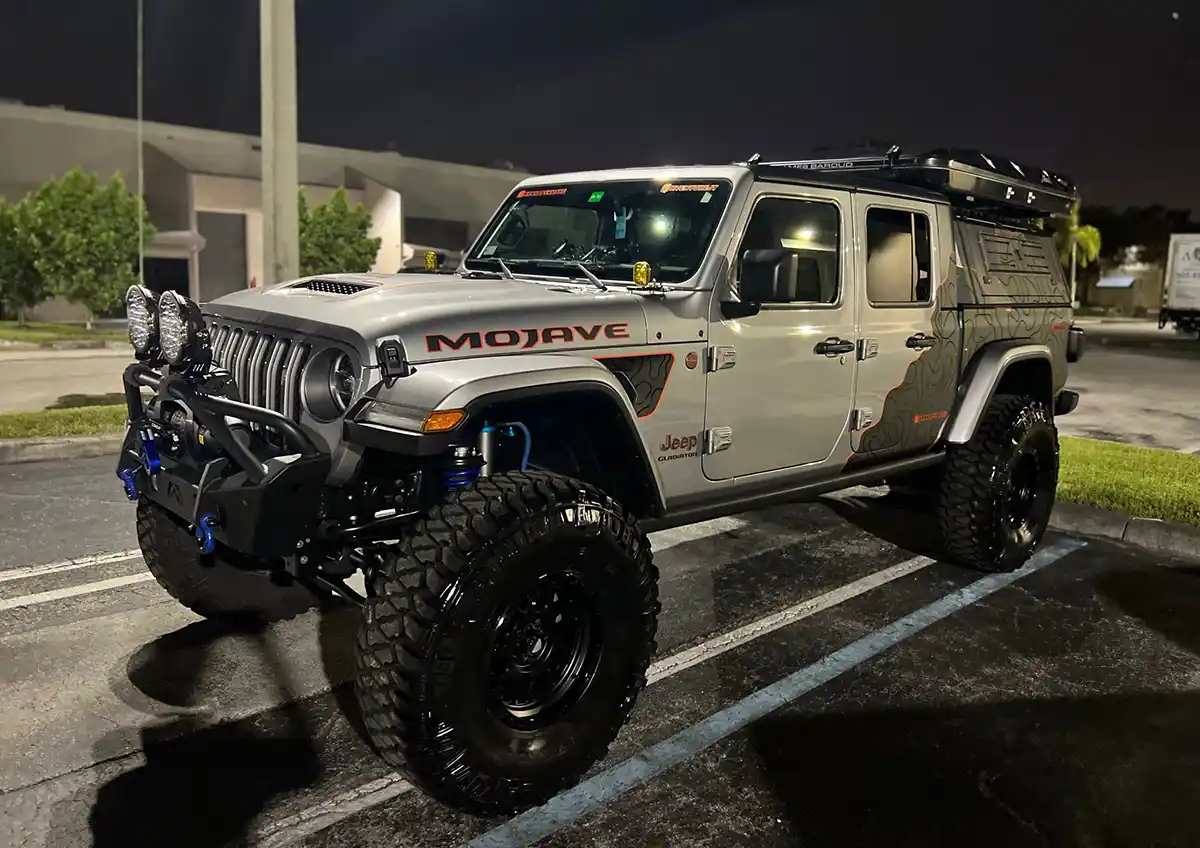
Jeep Gladiator with hard shell rooftop tent
5. Water and fuel storage solutions: Ensure self-sufficiency by adding water tanks, jerry cans, and fuel storage to your setup for longer trips in remote areas.
6. Cargo storage solutions: Use roof-mounted cargo boxes or rear cargo drawers to maximize storage space and keep your gear organized.
7. Recovery gear and winches: Essential for off-roading, recovery gear like winches and recovery boards ensures you’re prepared for when you get stuck.
Customizing your Jeep for rooftop camping transforms it into a fully equipped adventure vehicle. By upgrading your roof rack, suspension, lighting, and storage, you’ll be ready to tackle the most rugged overlanding trips with confidence.
Have an epic Jeep overlanding adventure to tell? Whether you’ve conquered rugged trails, camped under star-studded skies, or built the ultimate Jeep setup, we’d love to hear it! Inspire fellow overlanders with your unique experience
